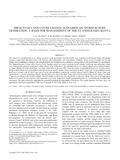Photosynthesis and productivity in heterogeneous arctic tundra: consequences for ecosystem function of mixing vegetation types at stand edges
1. Arctic vegetation tends to be spatially heterogeneous and can have large areas of mixed ‘transition zone’ vegetation between stands dominated by a single or few species. If plant photosynthesis and growth within these transition zones differs significantly from main vegetation stands, and if transition zones are not considered when extrapolating stand‐level findings to larger scales in space, then transition zones will provide considerable error to landscape‐level estimates of gross primary productivity (GPP).



